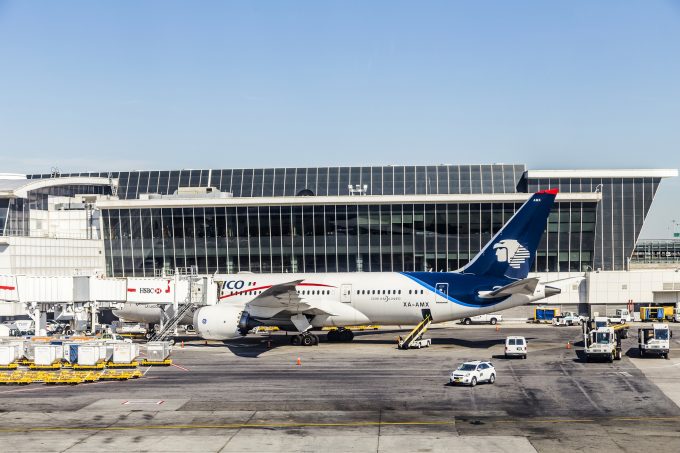Canadian Pacific Kansas City and Americold eye joint expansion in Mexico
Class I railway Canadian Pacific Kansas City and cold chain facility provider Americold are looking ...
FDX: ABOUT USPS PRIVATISATIONFDX: CCO VIEWFDX: LOWER GUIDANCE FDX: DISRUPTING AIR FREIGHTFDX: FOCUS ON KEY VERTICALFDX: LTL OUTLOOKGXO: NEW LOW LINE: NEW LOW FDX: INDUSTRIAL WOESFDX: HEALTH CHECKFDX: TRADING UPDATEWMT: GREEN WOESFDX: FREIGHT BREAK-UPFDX: WAITING FOR THE SPINHON: BREAK-UP ALLUREDSV: BREACHING SUPPORTVW: BOLT-ON DEALAMZN: TOP PICK
FDX: ABOUT USPS PRIVATISATIONFDX: CCO VIEWFDX: LOWER GUIDANCE FDX: DISRUPTING AIR FREIGHTFDX: FOCUS ON KEY VERTICALFDX: LTL OUTLOOKGXO: NEW LOW LINE: NEW LOW FDX: INDUSTRIAL WOESFDX: HEALTH CHECKFDX: TRADING UPDATEWMT: GREEN WOESFDX: FREIGHT BREAK-UPFDX: WAITING FOR THE SPINHON: BREAK-UP ALLUREDSV: BREACHING SUPPORTVW: BOLT-ON DEALAMZN: TOP PICK

Airfreight traffic in and out of Mexico keeps growing, buoyed by international carriers increasing capacity into the market.
The updraught is also attracting resurrected carrier Mexicana, which recently signalled plans for cargo flights.
Statistics from Mexico’s civil aviation authority show a 6.1% tear-on-year rise in airfreight tonnage in September, bringing the tally for the first nine months of the year to 940,840 tons, an increase of 7.1% over the same period last year.
International traffic was the primary engine of this growth. It was up 6.9% in September, resulting in a 9.4% nine-month gain, to 650,334 tons.
Unsurprisingly, Felipe Angeles International Airport (AIFA), the capital’s designated cargo gateway, showed the biggest gains, clocking up 336,790 tons over the first nine months, an increase of 28.8% – largely the effect of the ban on freighters at Benito Juarez, Mexico City’s chief passenger airport. Throughput at the latter slumped 56.4% to 175,483 tons.
However, the route that showed the biggest gain in international traffic in the period did not touch the capital. Cargo on the Queretaro-Memphis sector rose 10.9%, reflecting the fortunes of FedEx in the market, which is in stark contrast with the integrator’s US air network, which is shrinking after its contract with the US Postal Service expired in September.
Mexico’s rising fortunes, in large part due to nearshoring, keep drawing in international freighters. An A330P2F aircraft, delivered to Avianca in the summer, was given to Aerounion, its Mexican partner, to boost flights connecting its Latin American network with the US west coast, via Mexico. The aircraft raised the Mexican carrier’s capacity by 60%.
Lufthansa Cargo increased its freighter frequencies serving AIFA, Monterrey and Guadalajara in the summer, and stepped up passenger flights to Cancun. This was despite the challenges of serving two airports in Mexico City, passengers going to Benito Juarez and freighters to AIFA.
“We see still a challenge in having two airports in Mexico City.” said a spokesperson. “We have the same cargo volume but two production platforms, as freighters were banned from MEX in July 2024.
“This led to using trucks between the airports to align the handling of shipments coming on freighters in NLU and in bellies of passenger aircraft in MEX. We managed to handle this on an acceptable level, keeping a close eye on the caused costs.”
Airlines are also unhappy with airport charges in Mexico. Last month, airline interest group IATA urged the authorities to reconsider the increase of 39.7% in airport user fees on international flights. It claimed Mexican airport charges were the highest in the region and called for greater transparency in the fee setting process and for dialogue with stakeholders.
This call was seconded by Mexico’s national chamber of air transport.
Despite such issues, airline interest in Mexico remains high. One international carrier eyeing the country is Hawaii-based Pacific Air Cargo, which leases a B747 freighter from Kalitta Air and recently struck up an ACMI agreement with Atlas Air. It has signalled interest in a route from its Honolulu base to Mexico to tap into Asian export flows headed there.
The lure of cargo has also caught the eye of the Mexican military, which has been at the controls of Mexicana since the airline was resurrected last year, after the government acquired the rights to the brand. Last month, CEO Leobardo Avila announced that the carrier would start offering cargo flights “soon”.
He did not give details, but said Mexicana would be targeting “large supply chains”. And he cited the nearshoring trend as an opportunity for the airline to build connectivity to North America and countries in the Caribbean and South America.
Rival Aeromexico has seen its cargo volumes rise in a partnership with Amazon that has grown from a single route, connecting Monterrey with Merida, three years ago to 10 sectors, claiming annual volume growth in excess of 200%.
Comment on this article